This article is also featured in the third issue of B|ta’arof, a print magazine and website featuring visual arts, critical essays, curated archives, and oral histories about the collective histories of Iran across geographic and generational borders. You may purchase the issue here. All Photographs were taken by the author unless otherwise specified.

Over the past decade, municipality-led beautification programs aimed at rejuvenating cityscapes through new public art installations have dramatically refashioned Iran’s urban landscape. Beginning almost immediately after the 1978-79 Revolution, the newly established government sought to erase or subvert the symbols and public displays of the old regime and replace them with a new visual vocabulary situated within the grand narrative of the Islamic Republic. City streets, boulevards, squares, and building façades became sites for a new imagery that championed a revolutionary form of Islam and advocated anti-imperialist and anti-American sentiments.
With the beginning of the Iran-Iraq War in 1980, these same spaces were utilized for the war effort, propagating a visual rhetoric centered around themes of martyrdom in order to mobilize the populace. These murals outlived the war, acting as commemorative reminders of a generation lost to the conflict. The last few years, however, have seen large-scale municipal projects aimed at replacing many wartime murals (now viewed as spectacles of the macabre) with more hopeful visual motifs.
The development of Iran’s visual repertoire has become a popular example of state-sanctioned urban beautification, documented by scholars, filmmakers, and photographers alike. Many of these studies, however, do not explain the complex web of socio-political relations that are involved in the creation of such images. A capital-centric focus assumes that Tehran is representative of all of Iran and that “the state” is responsible for all the processes of production of public art. By viewing public art in Tehran as a direct byproduct of a single body, these discussions presume that there exists a centralized, top-down structure responsible for refashioning urban space through art.
Municipal politics around beautification programs reveal the complexity of governance in Iran and shatter illusions about the monolithic nature of the Iranian state. By exploring how local actors express often-contradictory opinions about the nature and future of Iranian cities, a fuller picture of modern life and politics in Iran emerges — one that highlights the diffuse nature of power and local decision-making in the Islamic Republic.
In fact, what appears in urban space is negotiated horizontally by different political institutions, showing that the state is not a monolithic entity; it consists of contested bases of power, each with its own vision of an ideal public space. Even though these struggles over urban space exist at a local level in Tehran, they are often read as an extension of national ideological trends. By using a provincial perspective to discuss public art installations in the city of Mashhad, one can see how the municipality’s beautification program is directly affected by local politics.
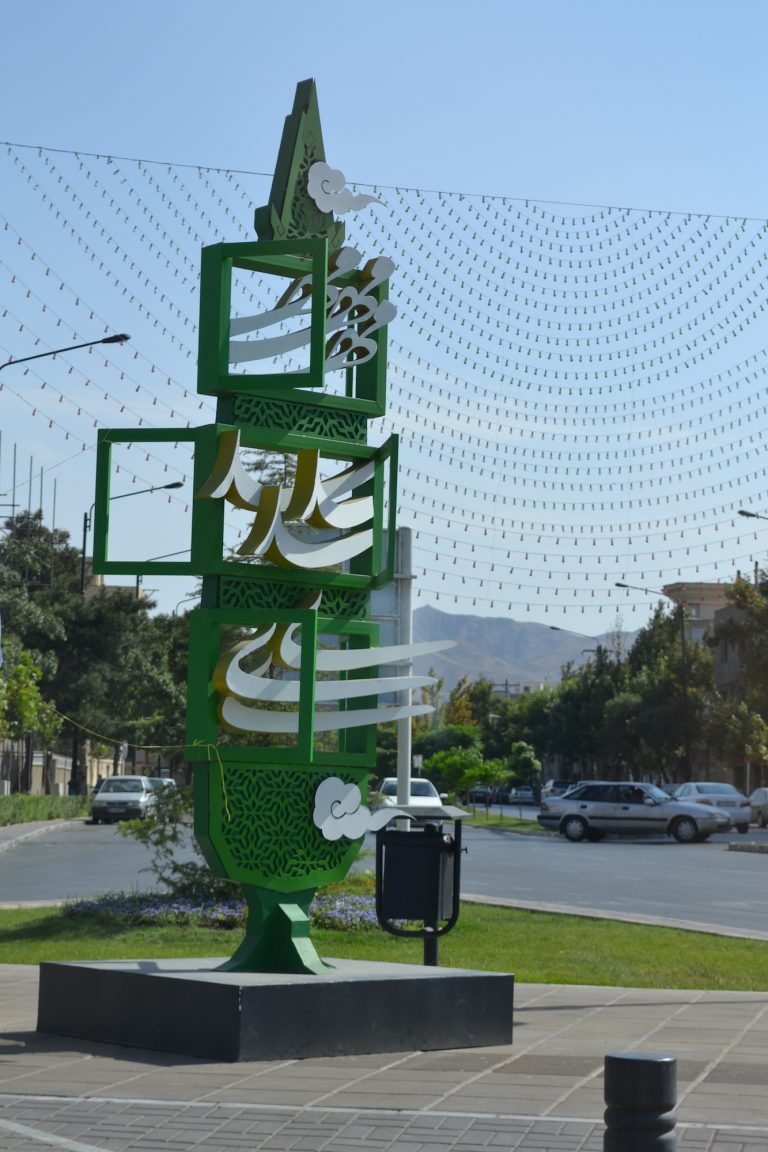
The Beautification Project
Mashhad’s municipal government has started a program to refurbish public areas that were previously dominated by wartime propaganda. Through the Office of Artistic Affairs of the Municipality of Mashhad (Modiriat-e Omur-e Honari-e Shahdari-e Mashhad), the municipality has installed new artistic works in large squares and boulevards, the sites that receive the most automobile traffic.
Over the last few years, the municipality created a large task force — comprised of teams of artists and university students —that has since decorated 734,000 meters of walls with over 2,000 individual works of art. Mashhad is now competing with Tehran for the title of Iran’s most decorated city.
Many of these new images were personally conceived and executed by the artists themselves, challenging the notion that Iranian artists are mere tools of a state propaganda machine. The municipality has even initiated a program that allows art students from public universities to paint a mural for their final term project.
The fact that members of civil society are responsible for the creation of public murals complicates a binary where art and propaganda are seen to be irrevocably divided. (It is important to note, however, that the municipality still retains final approval of all new installations and dictates which categories of art are considered appropriate for public areas. While the city government is undeniably present in the beautification process, Mashhadi citizens have a prominent role in the production of public art.)
In an interview with Shahr Ara on August 29, 2012, municipal art director Hadi Mozaffari outlined the new artistic categories featured on Mashhad’s urban landscape. The municipality has not ceased producing commemorative wartime murals and sculptures; the city government is still invested in perpetuating the cultural memory of the war. These works, however, account for less than 15% of planned installations. The vast majority of these art installations are an active departure from an aesthetic of melancholic remembrance, and instead celebrate the present-day realities and cultural heritage of the city.
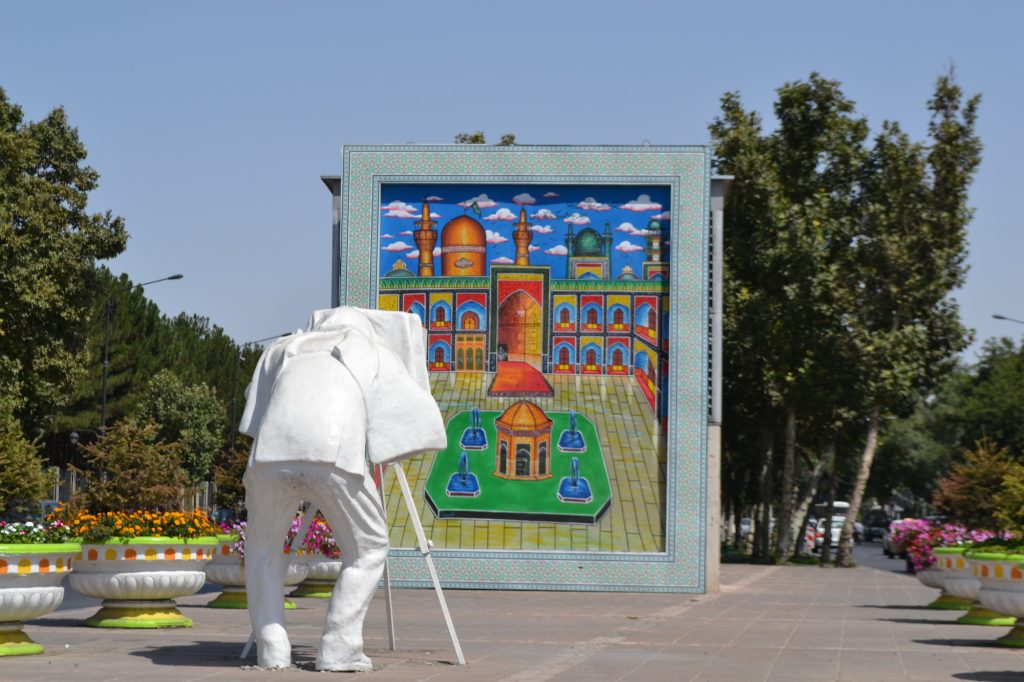
The first of such categories celebrates Mashhad’s prominence as a place of worship through depictions of the city’s iconic Islamicate architecture. Because of the Imam Reza Shrine complex, Mashhad is a major pilgrimage site attracting millions of domestic and international visitors a year. It is often considered the spiritual capital of Iranian Shi’ism. The significance of this site is reflected in the name of the city, which translates to “place of martyrdom,” equating the shrine with the city itself. The unique cylindrical dome and golden minarets of the shrine, or Haram as it is colloquially known, are featured prominently in these works.

The second artistic genre represented on Mashhad’s walls aims to reflect nature and the countryside. As the city continues to grow beyond its current population of three million citizens, the juxtaposition between urban and rural life becomes increasingly exacerbated. Much of the art in this category represents the countryside through the portrayal of flowers, fertile plains, and forests; there are also material installations that try to foster a suitable environment for the region’s local wildlife. These images are meant to bring elements of nature to the city, turning urban structures into visual representations of natural landscapes.

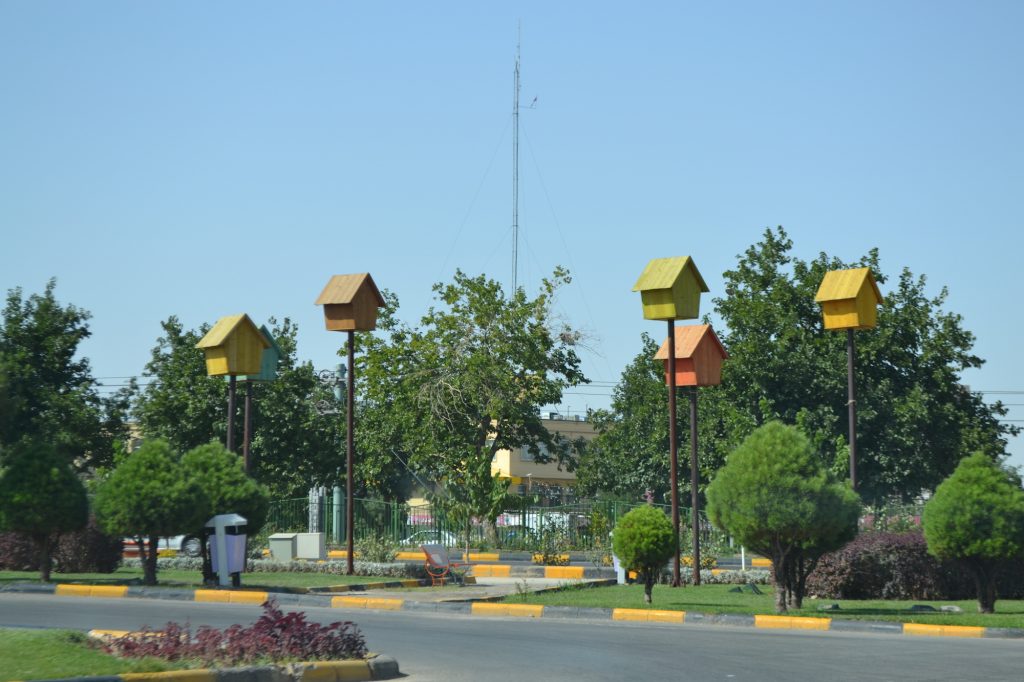
The third category celebrates Iran’s artistic heritage, specifically tile work, carpet weaving, calligraphy, and miniature painting. Although these handicrafts are still produced today, the industries have diminished significantly due to Mashhad’s absorption into global markets and changes in the city’s architectural aesthetic. By placing these artistic forms in public space, the municipality has re-appropriated and re-signified visual tropes. Apparently “traditional” forms have been assimilated into a modern city, reimagining the “traditional” as a modern conceit.



—Mozaffari states that the final category is intended to instill feelings of “happiness” (shadabi va khoshhali) in Mashhad’s citizens. By placing statues and murals reflecting childhood, kinship, and love, these installations offer citizens ethical guidance as to how they should lead their daily lives. Embedding works of art with messages of morality, the municipality has demonstrated its investment in defining the values appropriate for society at large.
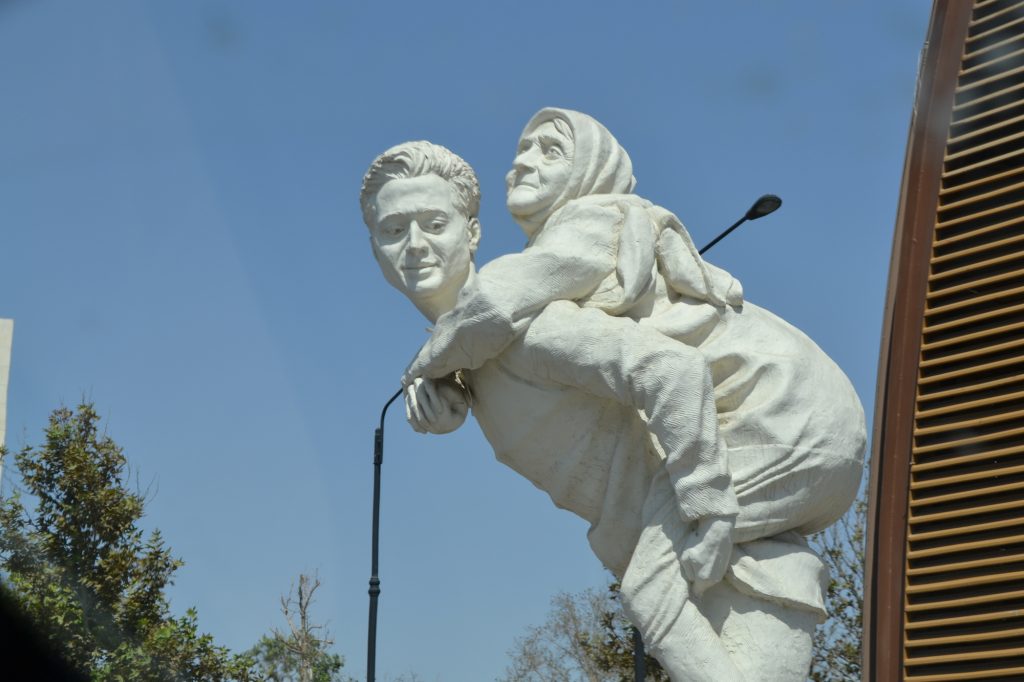
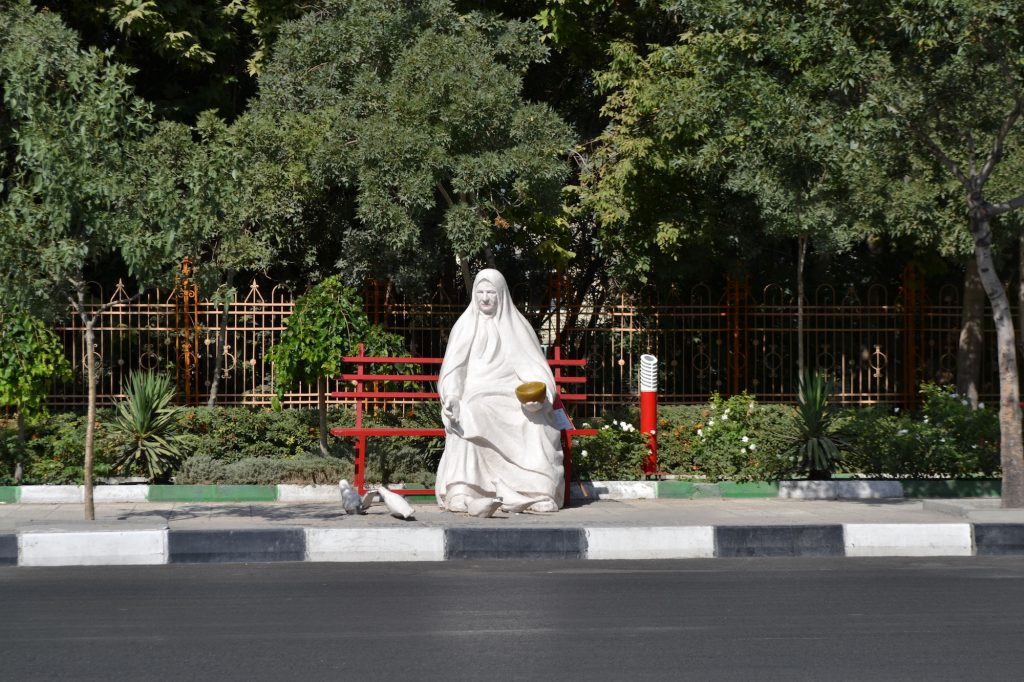
In addition to the categories mentioned above, the Administrative Office of Artistic Affairs has commissioned more than seventy works related to Hakim Abul-Qasim Ferdowsi, the 10th century poet and author of the Persianate epic the Shahnameh. The city of Mashhad is situated at an important intersection of two historical identities. There are two distinct (but not necessarily opposing) narratives informing Mashhad’s geographic setting, and they have often been absorbed into the contemporary political discourse of the city.
It is most commonly regarded as a holy city, established around the burial site of the eighth Shi’i Imam. Mashhad is also the capital of Khorasan province, the area largely recognized as the site of the reinvigoration of the Persian language after the 9th century. Ferdowsi’s tomb is a geographic epicenter of Persianate cultural revival and ethno-linguistic nationalism, located less than thirty kilometers away from Mashhad’s center in the city of Tus.
A Mural Erased
One Shahnameh mural in particular became the site of a struggle between several political institutions in Mashhad, polarizing these two narratives. In 2010, the Administrative Office of Artistic Affairs set aside the walls of Ferdowsi Square and Ferdowsi Boulevard (located four kilometers northwest of downtown Mashhad) to be decorated by a team of independent artists. Led by Mashhadi artist Neda Ra’ufian, the team spent over one year decorating 2,200 square meters of walls with scenes and passages from two sagas of the Shahnameh: the seven labors of Rostam and the downfall of the tyrant Zahhak. The project cost more than 45 million tomans (roughly $30,000 at the time) and was considered one of the largest and most expensive artistic projects in Iran. Completed in 2011, the mural wrapped around the entirety of the square, allowing commuters to view the stories as they travelled around the rotary. The installation was well received by the citizens of Mashhad, and many flocked to the area to photograph it.

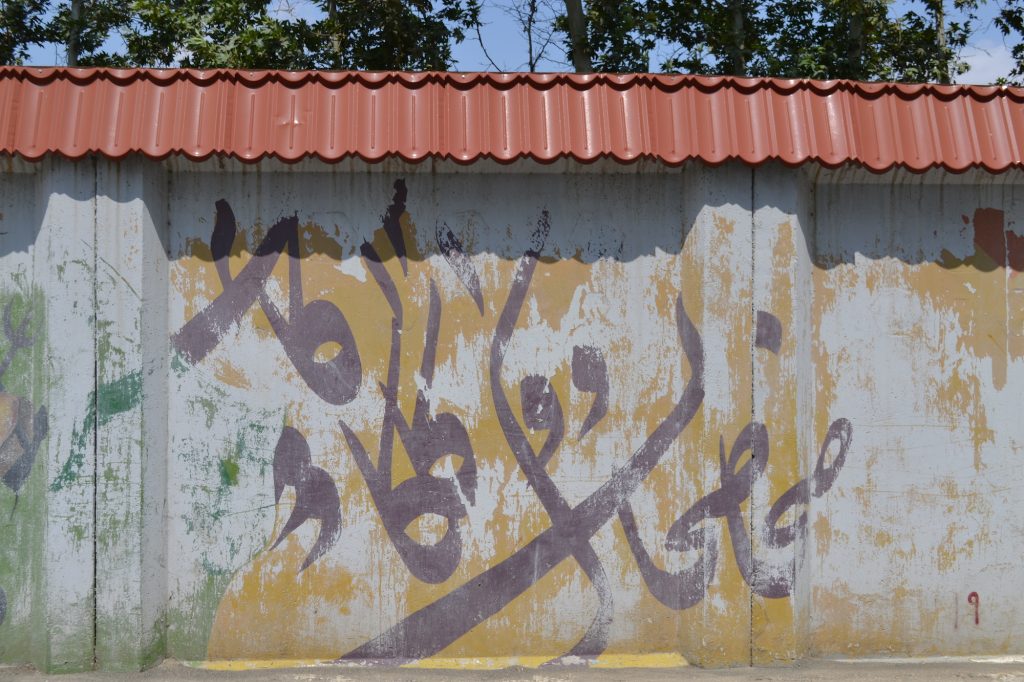
On the morning of June 5th, 2011, commuters were shocked to find that the mural had disappeared. The night before, a group of individuals equipped with hundreds of liters of white paint erased the installation within hours. After several days of confusion, speculation, and public outcry fueled by local newspapers covering the erasure, it was revealed that Astan-e Qods-e Razavi, a semi-autonomous administrative organization and charitable endowment that manages the Imam Reza Shrine complex, was behind the removal of the mural. But what prompted the charitable foundation (bonyad) to erase the mural?
Astan-e Qods is considered to be the oldest organization in Iran, tracing its roots to the years directly following the death of Imam Reza in 818 CE. Through the collection of inalienable tax-exempt religious endowments (waqfs) over the centuries, the institution has assumed control over large swathes of land throughout Khorasan. From the Safavid Era to the 1979 Revolution, the custodianship of Astan-e Qods was held by the monarch. With the establishment of the Islamic Republic, however, the bonyad was reorganized under the guidance of the new regime and allowed to expand significantly. It now employs more than 19,000 people and runs dozens of diverse institutions such as automobile, pharmaceutical, insurance, and agricultural companies with a net worth of $15 billion dollars. Such economic clout is felt virtually everywhere in the city of Mashhad, particularly in the realm of politics.
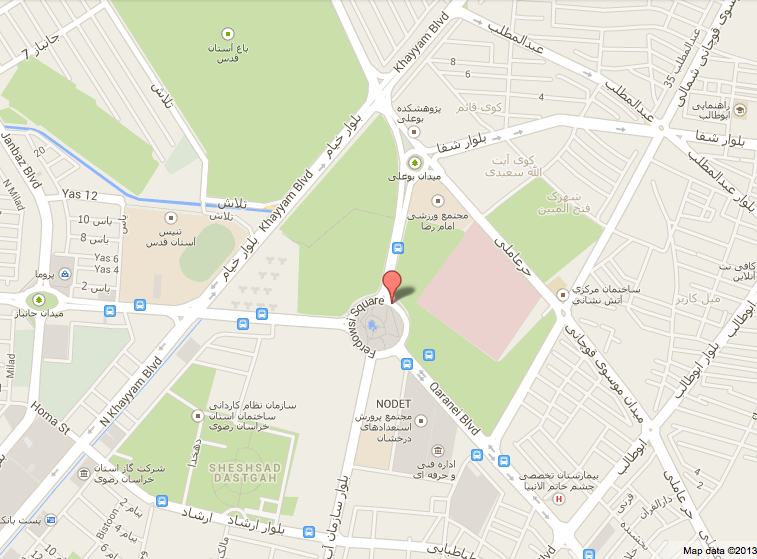
Over the subsequent days, a publicized debate took place between the municipality and Astan-e Qods over the right to beautify (or erase) the walls around Ferdowsi square. The walls on which the Shahnameh mural was painted belonged to Astan-e Qods, and it was removed by a division of the organization called the Department for the Preservation of Property and Land (Edare-ye Hefazat-e Emlak va Arazi).
According to the department, the municipality and the bonyad both agreed that the walls surrounding the square were to feature Arabesque designs; the municipality and the artists had painted the Shahnameh murals without the consent of Astan-e Qods. The municipality offered its own narrative, stating that Astan-e Qods was aware of the Shahnameh designs throughout the production process, even stopping work occasionally to question certain aesthetic choices.
While it is impossible to tell which narrative is closer to the truth, it is clear that the disagreement occurred over each institution’s vision of an ideal beautified public space. The municipality sought to celebrate the work of Iran’s national poet in the eponymous square, while Astan-e Qods removed the mural due to the secular nationalist connotations of Shahnameh imagery on its property.
One week after the erasure, Mozaffari challenged Astan-e Qods’ decision and stated that the mural would be replicated in its entirety in the same exact location. The bonyad was able to successfully argue that the walls encircling Ferdowsi square were in fact privately owned, giving Astan-e Qods the authority to combat what it considered to be secular imagery and to instead ensure a religious public sphere. The mural was reproduced with Ra’ufian’s assistance in 2013 in a different location, Park-e Se Rah-e Adiban, which is not owned by Astan-e Qods.
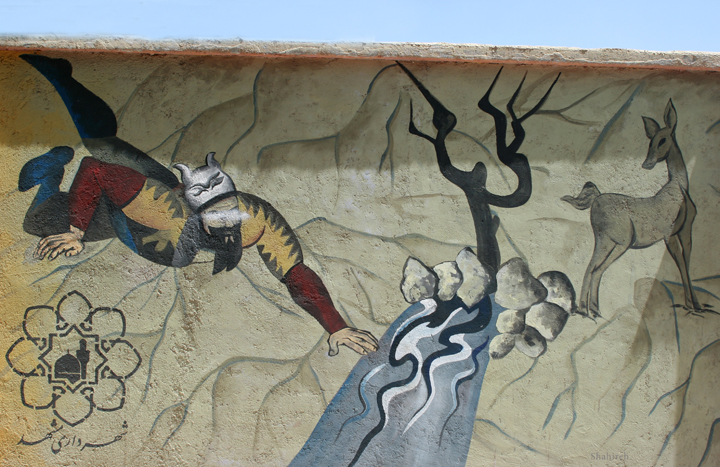

It is important to note that the negotiation of Mashhad’s visual landscape occurs on multiple fronts, not just between the municipality and Astan-e Qods. A similar “editing” of the public space occurred during the tenureship of the conservative Seyyed Ahmad Elm-ol-Hoda when he was the Friday prayer leader of Mashhad. From 2009 to 2010, Elm-ol-Hoda used his position to remove dozens of public statues that had been erected by the municipality. He also passed a decree banning musical concerts within an 80 kilometer radius of Mashhad due to its status as a holy city.
Just after the removal of the Shahnameh murals in Ferdowsi Square in 2011, another state actor got involved in the controversy. The local Revolutionary Guards compound, which is located less than a kilometer away from Ferdowsi Square, collaborated with the Administrative Office of Artistic Affairs in the spring of 2013 to fashion its own Shahnameh murals on its walls. Depicting large battle scenes of the adventures of Rostam, the murals directly face the Astan-e Qods sports complex, almost as if to challenge the bonyad’s erasure of the previous installation.
These new works were compatible with the nationalist orientation of the Revolutionary Guards, which relies on the revolution, war, and patriotism for legitimacy but does not advocate for the maintenance of an Islamic public sphere in the same manner as Astan-e Qods.


While various local political actors in Mashhad are able to negotiate public space, these avenues for visual representation are only available to state-sanctioned artists. All independently produced art is quickly removed with no media coverage or inquiries as to why the action was taken. Consequently, independent street art has to be relegated to areas with less automobile and pedestrian traffic, finding a prolonged existence away from squares and large boulevards.


By considering Mashhad, as opposed to Tehran, the nation’s capital, we can see how the visual language of the Islamic Republic is shaped by city politics. The state is not a monolithic entity with a hierarchical top-down structure that determines the cityscape. Instead, various intuitions of power vie with one another in their visions of an ideal urban aesthetic. In Mashhad, local political actors — including the municipality, Astan-e Qods, the Friday prayer leader, and the Pasdaran — have all participated in the negotiation of public space.
Mashhad’s dynamic beautification program documents a move away from commemorative murals of martyrdom and war in favor of a forward-looking orientation and increased optimism. The revolutionary visual rhetoric of the 1980s has been gradually supplanted with reflections of quotidian life — messages regarding familial relations, nostalgia for green space, and the celebration of national heritage.
Analyses of local political actors and of the diffuse nature of state power demonstrate the complex processes of power contestation within Iran — processes that are often erased in studies that imagine a monolithic state and a subservient people. Iranians work between and across state institutions in order to project various ideas of the public sphere; the artists who work for Astan-e Qods or the municipality are not merely propagandists, but instead active participants in a process of shaping that public sphere. The refashioning of urban space reveals the changing relationship between citizens and the government’s various institutions. We simply cannot continue to interpret Iranian politics in a top-down fashion, without misreading the writing on the wall.












9 comments
This is a great article! Thanks so much.